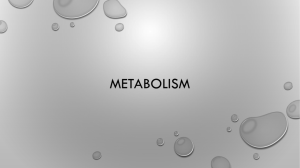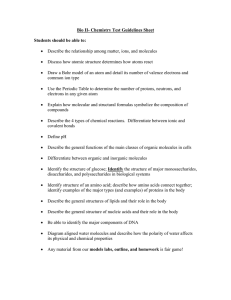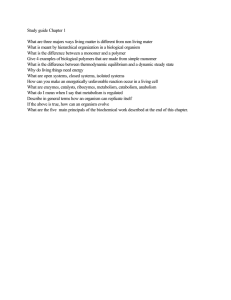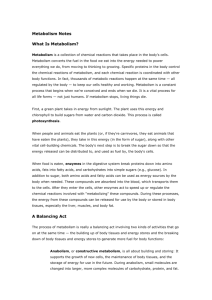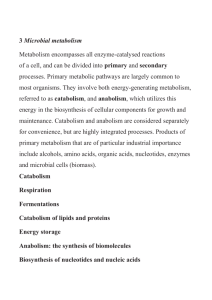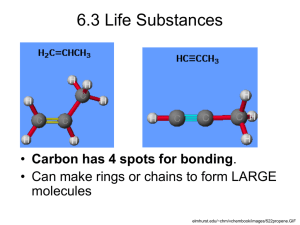Metabolism
advertisement
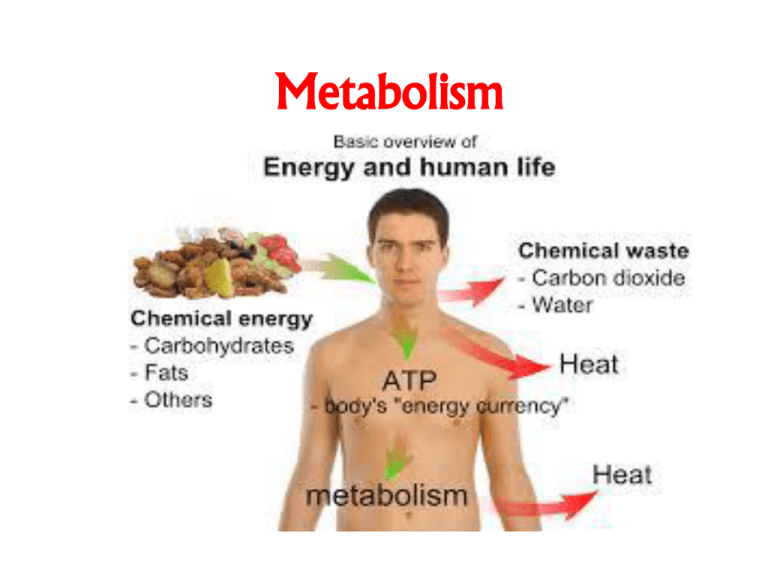
Metabolism السالم عليكم ورحمة هللا وبركاته Objective Explain what is metabolism, catabolism and anabolism. Be able to apply the latter two terms to various metabolic reactions. Describe in outline the metabolism of carbohydrates, lipids and proteins at the level of tissues and organs. What is metabolism? Metabolism is defined as the sum total of all chemical reactions that occur in the body. Metabolism is usually divided into two categories: Catabolism - larger molecules are broken down into smaller ones in a process that usually releases energy. Anabolism - larger molecules are made from small ones in a process the usually requires energy. 4 Two faces of metabolism • Catabolism - degradation • Anabolism - biosynthesis Catabolism Catabolism is that part of metabolism that involves the break down of large, complex molecules into smaller, more simplified products. This occurs during digestion, removal of hydrogen (dehydrogenation), carboxyl groups (decarboxylation) and amino groups (deamination), oxidation, etc. Anabolism Anabolism is that part of metabolism that involves the synthesis of larger, more complex molecules from small, simple reactants. Examples of anabolism would include the synthesis of glycogen from glucose, protein from amino acids, fat from glycerol and fatty acids and construction of new antibodies and new enzymes. Anabolism Copyright © The McGraw-Hill Companies, Inc. Permission required for reproduction or display. H H H O C OH HO C (CH2)14 CH3 H O C O O H C OH HO C C OH HO C (CH2)14 CH3 O (CH2)14 CH3 H C O O H C C H2O H2O H2O (CH2)14 CH3 O (CH2)14 CH3 H H C O C (CH2)14 CH3 H + Glycerol 3 fatty acid molecules + Fat molecule (triglyceride) Copyright © The McGraw-Hill Companies, Inc. Permission required for reproduction or display. 3 water molecules Peptide bond H H N H C C R Amino acid H H O N O H H + C H O C R Amino acid N O H H H O C C R R N C H H Dipeptide molecule O C OH H2O + Water 9 Key Biochemicals Most of the structures that make up animals, plants and microbes are made from three basic classes of molecule: amino acids, carbohydrates and lipids (often called fats). As these molecules are vital for life, metabolic reactions either focus on making these molecules during the construction of cells and tissues, or by breaking them down and using them as a source of energy, by their digestion. These biochemicals can be joined together to make polymers such as DNA and proteins, essential macromolecules of life. . Overview of Dietary Catabolism Large molecules in food are broken down into smaller units. No useful energy is captured in this phase. These numerous small molecules are degraded to a few simple units that play a central role in metabolism. Some ATP is generated in this stage. Cell ATP is produced from the complete oxidation of the acetyl unit of acetyl CoA, the final common pathways in the oxidation of fuel molecules. Three stages in the generation of energy from the oxidation of foodstuffs 12 Carbohydrate Metabolism: Fate of Glucose 1. Glycolysis (enzymatic breakdown and interconversions of carbon atoms derived from glucose) ultimately yields ATP and CO2. 2. Converted to glycogen, a storage polymer of potential metabolic energy. 3. Generates reducing equivalents (NADPH) for fatty acid synthesis and ribose for nucleotide synthesis (via the pentose phosphate pathway) 4. Triose phosphate can be metabolized to the glycerol backbone of triacylglycerols (fat). 5. Pyruvate (and other metabolites) can provide the carbon skeletons for synthesis of nonessential amino acids; acetyl CoA necessary for long chain fatty acid and cholesterol synthesis. Carbohydrate Metabolism Lipid metabolism 1. Esterified and stored as triglycerides. 2. b-Oxidation of fatty acids generates energy and leads to acetyl-CoA (which enters the citric acid cycle). 3. It is the precursor for synthesis of cholesterol and other steroids. 4. Can form ketone bodies in the liver (energy sources during starvation conditions). Lipid metabolism Amino Acid Metabolism: Essential and Non-Essential 1. The amino acids are required for protein synthesis. Some must be supplied in the diet since they cannot be synthesized in the body (essential amino acids). 2. The remainder are non-essential amino acids which are supplied in the diet, but can also formed from metabolic intermediates by transamination and deamination reactions. Amino Acid Metabolism
